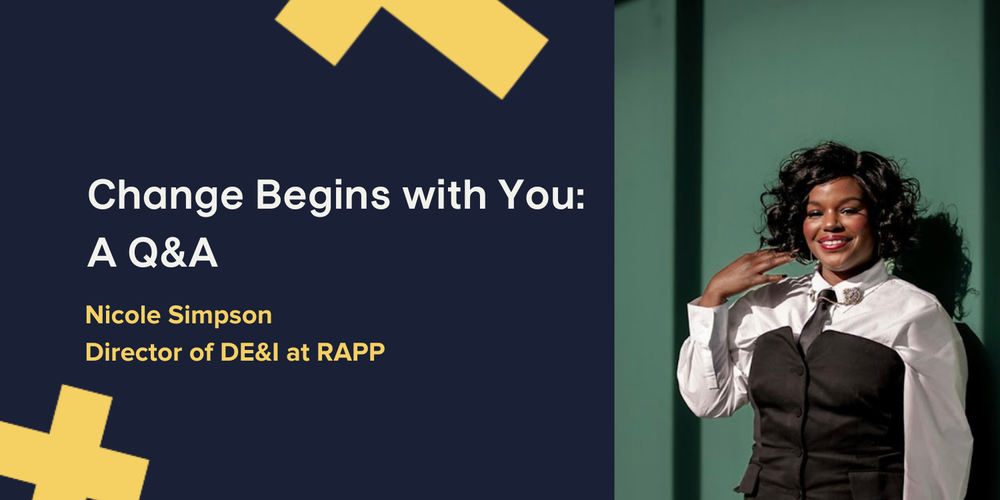Change Begins with You: How to Create More Inclusive Workplaces from the Bottom Up
Shifting workplace culture can seem overwhelming, even more so if you aren’t in a leadership role. At those times, it’s important to remember that anyone can be a leader; making change doesn’t depend on your job title or professional level. The only requirements are a passion for inclusion, a strategy that aligns with organizational objectives, and a vision for a more positive work environment, where everyone has a sense of belonging.
Nicole Simpson, Director of DE&I at RAPP

Nicole Simpson joined Omnicom Health Group as a corporate paralegal in February 2020, and within months, she had launched an employee resource group aimed at addressing the need for recruitment, inclusion, and retention initiatives for Black professionals. Today, Simpson is the Director of Diversity, Equity, and Inclusion at RAPP, a global creative marketing agency, and frequently shares her framework for gathering leadership support, enlisting allies, and creating better workplaces from the ground up.
First, why is leadership buy-in so important to the success of any initiative?
Senior leaders set the directives for the organization. They're also the people who are going to tell your story and talk about the impact that you’re trying to have on the company. You need their buy-in to be able to create organizational change. Full stop.
It's also not as simple as writing an email and saying, “I want X,Y, and Z.” You have to get to know your key stakeholders before jumping into any conversation about what you want. You need to understand how they think and what motivates them, so you can present your case in a way that they’ll listen. You need to be able to speak their language, and you need to understand what keeps them up at night. Building relationships also gives your stakeholders an opportunity to understand more about you, your character, your passions, and your vision. And because you've shown a vested interest in them, they'll be more willing to lend you a hand. It's a symbiotic relationship.
It seems that relationships are even more important when a senior leader is neutral about diversity, equity, and inclusion, or even has negative feelings about DEI.
As a DEI practitioner, my job is to get people to look at each other as humans. You have to take the scariness out of it and just connect on a human level. It’s important to be open, to be an active listener, and to really care about the other person. That need for empathy sometimes gets lost in conversations about the purpose of DEI.
What steps should someone follow to prepare for a meeting with senior leadership?
There isn't necessarily a single recipe for success. However, I've used the following method at different times, and I’ve helped other people use the same framework successfully.
- Power in Numbers: Don’t go into the room alone. It’s really important for you to find your allies. Find the people who are going to walk into the room with you, stand with you, and help you make your case. It can be easy to ignore one person, but you cannot ignore an army, so to speak. You have to be strategic about who you're bringing into the room with you, depending on how you're going to present your case, and what evidence you’re using to try to move leadership.
- Gather your data: You have to present your case with facts. Leaders can't act on feelings, but they can act on facts. When I present facts that show how organizations that are truly committed to having an inclusive and diverse organization make 25% more than companies that do not, that is a fact that you cannot dismiss. When you are asking for resources, you have to show up with facts, because data drives change.
- Have a great story: You then have to put the data into a container that tells a really strong story, one that leadership can instantly understand. That looks different for every organization, but a compelling story includes what the data is telling you: where you stand today, what the potential problems are, and what is likely to come in the future.
- Present a solution: The most important piece is offering a solution to those problems. There are a lot of people who will just raise the concern, say, “This is a problem,” and then drop the issue and expect it to be solved. I've found that when you bring a solution to leadership – not that everything is set in stone – but you should have some ideas about what can be done. Bring your ideas, then you can co-create a strategy and help execute the solution. You’ll get faster results if you are part of the solution, but it’s also a way to elevate your presence with leadership. You’re essentially saying, “I'm capable of identifying a problem. I'm capable of showing you a solution. And I'm capable of helping you execute.”
Can you explain what you mean by “being strategic” about your allies?
To me, being strategic means understanding if this person is going to come with me on my journey or not? That’s why it’s so important to get to know people and form relationships first. You can very quickly discern whether they are open to your ideas or not, whether they're going to help you or not. Just from a numbers perspective, who is in leadership? Who can bring about change? Often those people are White, cisgender, heterosexual men, and you need them because they are in the room where it happens.
Why is enlisting allies such a crucial step?
You need allies because they have influence. These decision-makers can help you shepherd in the change that you want to see, because you can't make systemic organizational change by yourself. You need allies who are in the room, but also allies who are going to go into the room with you and walk with you. That means that you need people who believe in your message and also have some capital to spend in that room.
For example, when I needed to present to my executive leadership team about the fierce need for recruitment and retention initiatives for Black professionals at that organization, I strategically recruited six Black executives from the company network to come with me, because I knew that it would give me credibility.
How do you approach someone and ask them to support you?
The first step is to identify people you’d like to get to know. At your company town halls, for example, you get to hear from a myriad of leaders. If you hear someone interesting, reach out to them. There doesn't have to be any intent other than wanting to get to know them. Once I learn about someone, I start to understand their superpower. I also think about how I can be of service to this person.
One thing that I did well when I was trying to gain support was offering myself as a resource. I found out what was keeping the other person up at night, and I would offer my help – either introducing them to someone with the skills they needed or offering to co-create a solution. That let them know that I was just as interested in pouring out as I was in receiving support. I don't think you should ever ask for something without offering something.
Do you have any other encouraging advice?
Going on this journey helped me understand my passion and my purpose. It wasn't an accident, because I put the thought into the universe: “I want to do something. I want to impact change.” But, I didn't know what it was going to look like until I went on that journey. I would encourage anyone who's feeling that urge to see change happen, to start walking on your own journey. You don't know what's going to come from it, but change is possible. Anything is possible, regardless of your title or your tenure, as long as you have a strong framework and allies to help you.
At TDM, we can help you develop strategies to showcase the value of DEI and increase support across your organization. We can also provide actionable steps to establish and maintain an effective employee-led group. For more information on how we can help you on your DEI journey, contact us today.




